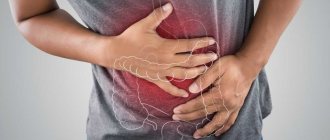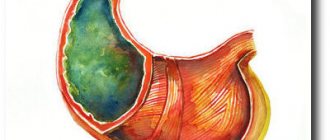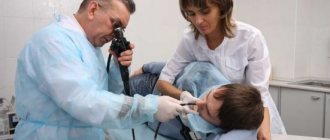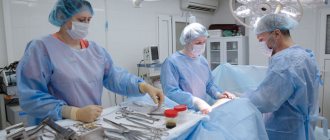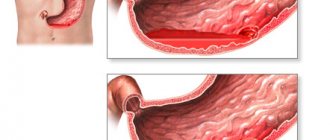The length of the small intestine in a healthy person is approximately 6 meters. The total surface area of the small intestinal mucosa is enormous - about 500 m2, which is comparable to the area of a tennis court; colon – 4 m2 – equal to the area of a table tennis table. When a large part of the intestine is removed, its functions are significantly reduced, which leads to intestinal failure and the appearance of short bowel syndrome. Recovery is especially difficult if less than 2 meters of intestine is preserved.
The main reasons why extensive bowel resection is performed:
- thrombosis and embolism of intestinal vessels (30-90%);
- Crohn's disease (50%);
- Gardner's syndrome (20%);
- periarteritis nodosa (15%);
- intestinal tumors (1-16%);
- post-radiation enteritis (10%);
- intestinal angiomatosis (4%).
Intestinal anatomy
Food from the stomach enters the small intestine, which consists of three sections that differ in their functions. Next, a lump of digested food - chyme - enters the large intestine, which also consists of three sections. Between them is the ileocecal valve, which acts as a valve. The lower section of the large intestine - the rectum - serves for the accumulation of feces and ends at the anus.
Stages
Colectomy is a surgical procedure in which all or part of the colon is resected. Surgery that involves removing the entire colon is called a total colectomy. If most of the intestine is removed, the procedure is called a subtotal (partial) colectomy. If a segment of bowel is removed, the procedure is called a segmental colectomy and may be labeled a right or left colectomy (or hemicectomy). Extirpation of the rectum is the complete removal of the last part of the intestine for diseases of various etiologies.
Operation options
Depending on the location of the pathology for which the operation is performed, part or all of the small intestine, part of the colon, or the rectum may be removed. There are three types of resection.
- Removal of part of the small intestine while preserving part of the ileum, ileocecal valve and large intestine. Such patients rarely experience serious postoperative disorders.
- Removal of part of the jejunum, the entire ileum and ileocecal valve to create a connection (anastomosis). These patients will have steatorrhea, nutritional deficiencies, and other disorders. However, over time, the body can adapt to new conditions.
- Resection of the large intestine (colectomy) with the creation of an artificial fistula from the jejunum (jejunostomy) or ileum (ileostomy) through the abdominal wall to the outside. Feces will be expelled through the created hole, which is why it is called the unnatural anus. In such patients, no bowel adaptation is observed. It is possible to constantly take saline solution, glucose, antidiarrheal drugs, and in some patients, parenteral nutrition.
Types of operations
Intestinal operations can be:
- Laparoscopic – minimally invasive. Through 3-5 small incisions on the abdomen, manipulators are inserted into the abdominal cavity. Operations are easier to bear and recovery is faster.
- Laparotomy is a classic open operation. One large incision is made on the abdomen, expanding which the surgeon examines the surgical field and performs the necessary manipulations. Recovery takes much longer, complications are more common, and the patient has more restrictions. Unfortunately, laparoscopic surgery is not possible for everyone. Laparoscopy, like any other procedure, has its contraindications.
- Surgeries on the intestines without removing part of the organ.
- Resection of the small intestine - removal of a small section of the intestine (duodenum, jejunum, ileum).
- Removal of the small intestine - one section of the small intestine is completely removed. The duodenum is rarely excised completely, since after this the patient will not be able to absorb most of the vitamins and minerals (iron, calcium, folic acid, fat-soluble vitamins A, D, E, K). Removing the ileum leads to impaired fat digestion and worsening diarrhea. Cutting out 50% of the small intestine leads to severe digestion disorders. If, according to strict indications, the patient needs to remove almost the entire small intestine (75% or more), then for the rest of his life the person will be forced to eat special mixtures through a dropper.
- Colon resection is the removal of a small section of the large intestine (colon, sigmoid, rectum).
- Removal of the colon (colonectomy). If part of the intestine is cut out, the operation is called a hemicolectomy.
Features of postoperative disorders depending on the site of resection
Depending on which part of the organ was removed, certain symptoms predominate.
In the small intestine, all types of nutritional compounds are digested, and the vast majority of hydrolyzed substances, vitamins, microelements and water are absorbed here. Resection of the small intestine leads to:
- deficiency of all types of nutrients in the body during their normal entry into the digestive tract;
- diarrhea due to a sharp decrease in water absorption.
Each part of the small intestine has its own job to do, so resection of different parts of the intestine results in different symptoms.
Water and nutrients are absorbed primarily in the upper intestine (jejunum). Secretions produced in the digestive tract, bile, and enzymes are absorbed mainly in the lower section (ileum), and part of the water is also absorbed here. That's why:
- Resection of the jejunum is not accompanied by diarrhea, since the remaining ileum takes over the absorption of fluid.
- Removal of the ileum causes severe diarrhea, since there is no place for the secretions produced in the previous parts of the tract to be absorbed, they liquefy the chyme, thereby causing watery, frequent stools. In addition, in the absence of the ileum, bile and fatty acids are not absorbed, which pass into the large intestine, where they attract water, aggravating diarrhea.
The ileocecal valve, which closes the passage between the small and large intestines, is of great importance in digestion. Removal of this valve during extensive resection of the small intestine:
- accelerates the passage of chyme, which leads to decreased absorption of electrolytes, nutrients and fluids;
- promotes the penetration of microflora from the large intestine into the small intestine, which leads to the appearance of excess bacterial growth.
In the large intestine, some of the water and electrolytes are absorbed, and feces are formed. The microflora of this part of the organ synthesizes B vitamins and vitamin K. The final fermentation of fats into short fatty acids, which are important energy substrates and also have an antimicrobial effect, takes place here.
Resection of the large intestine leads to the loss of some water and minerals and a lack of vitamins. Feces do not have time to form. Preservation of the colon significantly compensates for impaired absorption of carbohydrates and fats, as well as fluids.
The totality of all disorders arising as a result of intestinal resection is united under the general name – short bowel syndrome. All emerging disorders are caused by:
- digestive disorders;
- malabsorption;
- trophological deficiency;
- involvement of other organs in the pathological process.
Carrying out the operation
Typically, an intestinal resection operation due to detected polyps includes two stages . The first is called direct resection of the required section of the intestine. The second is anastomosis.
Bowel resection can be completely different. In many ways, its nature depends on the underlying process that provoked damage to the intestinal section or the organ as a whole. Therefore, depending on this, the choice of anastomosis option occurs.
Operation methods
In addition, there are several methods of surgical intervention. The classic one is laparotomy, which involves making an incision in the abdominal wall and creating a surgical wound.
There is also a laparoscopic method, when surgery occurs through a small hole. This is the leading access when performing intestinal resection. It is most often used by surgeons when performing intestinal resection. The choice in its favor is due to the fact that the traumatic effect on the abdominal wall during laparoscopic resection is much less severe. In addition, after surgery using this method, the patient’s recovery after surgery on the intestines is noticeably faster.
Complications after intestinal surgery
The consequences after surgery to remove the intestines can be very different. For example, this could be diarrhea after intestinal surgery. the following complications may occur in the postoperative period
- an infectious process appears;
- obstructive obstruction, in this case there is scarring of the intestinal wall at the site where the connection occurred;
- bleeding that occurs during the postoperative or intraoperative period;
- the appearance of a hernial protrusion in a place on the abdominal wall.
Recovery after bowel removal
Changes in the body after intestinal resection surgery occur in three stages.
- The postoperative stage lasts from a week to several months. Characterized by water diarrhea (up to 6 liters per day), accompanied by loss of sodium, potassium, chlorides, magnesium, bicarbonates. This causes dehydration and severe electrolyte deficiency, the development of severe metabolic disorders, and disruption of protein, water, electrolyte and vitamin metabolism.
- The subcompensation phase continues for a year after intestinal resection. There is a gradual adaptation of the digestive system: the frequency of stool decreases, metabolic processes are normalized. In this case, the absorption of nutrients is not restored. Therefore, there is a deficiency of vitamins and anemia, manifested by general weakness, dermatitis, sensitivity disorders (numbness, goosebumps, tingling), dry skin, brittle nails. Almost all patients are underweight.
- The adaptation phase begins approximately two years after intestinal resection. To begin, a compensatory structural restructuring of the small intestine is necessary. If the intestines adapt, the patient's condition will stabilize. Symptoms of diarrhea will decrease and body weight will be restored. But complications may arise in the form of the formation of stones in the gall and bladder, and the appearance of stomach ulcers. Anemia may persist.
After intestinal resection, restoration of functions is possible if the following is provided as early as possible:
- normalization of the content of proteins, fats, carbohydrates, vitamins in the body;
- the beginning of stimulation of digestion;
- the beginning of absorption processes;
- restoration of intestinal microbiota.
The most effective way to start adaptation processes in the intestines is to make it work. Without the supply of nutrients, the organ will not begin to recover. Therefore, it is important to start enteral nutrition as early as possible. Contact of nutrients with enterocytes triggers the synthesis of hormones and enzymes of the intestines and pancreas, which stimulates adaptation processes. The nature of your diet also plays a big role. The diet should contain dietary fiber, glutamine, and short fatty acids.
The main tasks in restoring the intestine after surgery
A rehabilitation technique for intestinal restoration after surgery should include the following tasks:
- normalization of intestinal perilstatics (restoration of physiological motility with regular bowel movements);
- preventive measures to prevent dysbiosis of medicinal origin, dyspepsia;
- improving the process of digestion and assimilation of food, restoring damaged intestinal mucous membranes;
- preventing the development of possible postoperative complications;
- improving the quality of life of the operated patient.
Principles of nutrition in the postoperative period
In the postoperative period of intestinal resection, to save the patient’s life, measures to prevent complications: dehydration, hypovolemia, hypotension, and electrolyte disturbances are paramount. When these conditions are eliminated, 2-3 days after surgery, they begin to establish parenteral (bypassing the digestive tract) nutrition with the introduction of energy substrates. Large volumes of glucose, isotonic solutions of sodium chloride, calcium salts, potassium, and magnesium are administered intravenously.
When the patient's condition is stabilized and diarrhea is under control, enteral (using the digestive tract) nutrition is prescribed. After a small intestinal resection, nutrition is prescribed for 3-5 days, after an extensive one - through a tube after 2-4 weeks. Diarrhea may worsen after enteral nutrition is started. However, it cannot be stopped; the rate of drug administration must be reduced.
Gradually, as the patient’s condition improves, they switch to normal oral (oral) nutrition. Usually diets No. 0a, 1a, 1, 1b are prescribed sequentially.
Diet 0a has a low energy value, so the patient experiences nutritional deficiencies. Lack of proteins is especially dangerous. The processes of catabolism begin to dominate over the processes of synthesis, the recovery mechanisms are inhibited, which is fraught with an unfavorable outcome, especially if the metabolic processes were already disrupted before the operation. Therefore, a combined diet with parenteral and enteral administration of nutrients is prescribed. The total calorie content is significantly increased and amounts to up to 3500 kcal per day.
If the zero diet is well tolerated, after 2-3 days the patient is prescribed diet No. 1a (another name is 0b). As a rule, the patient remains on this diet after intestinal resection until discharge from the medical facility.
Postoperative period after intestinal surgery
The main task of the postoperative period, regardless of the type of intervention, is the most complete restoration of the functions of the organs on which the operation was performed. To accomplish this task, the following goals are set for rehabilitation therapy:
- prevention of complications;
- anesthesia;
- removal of mobility restrictions;
- acceleration of recovery;
- psychological recovery after illness;
- return to an active healthy life.
The postoperative period is divided into 3 types - early, late and long-term. Early is considered to be the period from the completion of the operation to 6 days of hospital treatment. The late postoperative period includes the period from 7 days until the patient is discharged from the hospital. Long-term postoperative period is considered to be the period from discharge until the patient’s complete recovery. For a speedy recovery, all patients who have undergone surgery should follow simple rules:
- Carefully follow all recommendations of your doctor.
- Follow the regime.
- Eat according to the prescribed diet.
- Avoid physical activity.
- Don't drink alcohol.
- Stop smoking.
- Get medical examinations regularly.
- If you experience discomfort, abdominal pain or other symptoms of illness, you should consult a doctor immediately.
Principles of nutrition after discharge
Prescribing the right diet and strictly following it are the most important conditions for recovery.
Two weeks after intestinal resection, the diet is changed from No. 1a to 1 surgical diet. But within 3-4 weeks it is recommended to wipe all food. The principle of thermal and mechanical sparing must be observed. Dishes are steamed or boiled, all food is thoroughly crushed to a liquid or mushy consistency, fruits are pureed, and jelly and compotes are prepared from them. Avoid products that increase rotting and fermentation - canned food, smoked foods, spices.
If this diet is well tolerated, you can gradually switch to the unprocessed version of the surgical diet No. 1. This means daily reduction of dishes with maximum mechanical and thermal processing. Good tolerance of a new dish indicates the formation of compensatory reactions of the digestive tract, normalization of its functions, which allows you to expand the diet. Such a transition should take at least 2 weeks, and sometimes up to 5-6.
In the unprocessed version of the diet, food can be boiled; after boiling, it can be baked in pieces. A wider selection of vegetable and fruit purees and compotes is allowed. Meals should be small meals - at least 6 times a day.
The consequences of intestinal resection include increased sensitivity of the digestive tract to certain foods. First of all, we are talking about whole milk, as well as fatty foods, including vegetable oil, strong broths, decoctions, fresh vegetables and fruits, and sour foods. Milk intolerance is observed in 65% of patients after intestinal resection; in this case, the diet needs to be changed; there is no need to practice “training” the fragile organ with dairy products. Whole milk should be replaced with soy or other plant milk for several months or even years until lactose intolerance passes.
Gut restoration methods
Intestinal restoration during surgery involves the use of basic methods, which are discussed in more detail in the list below.
- Drug therapy. For recovery, enzymes, probiotics, and regulating agents for restoring motor skills are most often prescribed. This category of drugs has a temporary effect, since after the end of treatment the discomfort may return.
- Phytotherapy. Medicinal herbs, when properly selected, give the desired result and help restore impaired motor skills in a fairly short time. Folk remedies improve metabolic processes, stabilize the functioning of the liver, stomach, and gall bladder, which is necessary after surgery.
- Compliance with a therapeutic diet. This method is one of the main ones in restoring the body, and nutritional principles are prescribed individually depending on the general condition of the patient.
Meals should be divided up to 5–7 times a day every 3–4 hours. Dishes are prepared using safe culinary processing methods (steaming, baking). It is best to consume pureed vegetable purees, soups, and drink plenty of water in the form of rosehip decoction or warm still mineral water.
- Prescription of breathing exercises. Carrying out surgical intervention involves performing special exercises (forced exhalations, inhalations, inflating a balloon). Such manipulations make it possible to ensure normal ventilation of the lungs and prevent the development of bronchitis and pneumonia. It is recommended to perform the procedures daily during prolonged bed rest.
- Painkillers. The intake of analgesics and antispasmodics depends on the type of surgical intervention used and the general condition of the patient. For open wounds, intravenous narcotic drugs (Droperidol) are administered during the first 2–3 days. With further recovery, non-narcotic medications are taken (Ketorolac, Ketanov, Diclofenac).
- Seam processing. Postoperative sutures should be inspected daily and treated with antiseptic solutions. The patient should not scratch or wet the scars too much. If any complications occur (swelling, redness, bleeding), you should see a doctor immediately.
- Conducting physical therapy. A patient’s recovery after surgery largely depends on the individual characteristics of the body. All manipulations (sitting, walking) should be carried out only with the permission of the attending physician.
Diets in the first month after surgery
In the first month after resection, both the small and large intestines are prescribed the same diet.
Diet 0a.
Appointed for two to three days. Food is liquid or jelly-like. The calorie content of the diet is 750-800 kcal. You can drink about 2 liters of free liquid.
Allowed: weak meat broth without fat, rice broth with butter, strained compote, liquid jelly, rosehip broth with sugar, no more than 50 ml of freshly prepared juice from fruits or berries, diluted 2 times with water. On the third or fourth day, when the condition has stabilized, you can add a soft-boiled egg, butter or cream.
Exclude: dense foods, whole milk and cream, sour cream, vegetable juices, carbonated drinks.
Diet 1a surgical.
Calorie content 1500-1600 kcal, liquid - up to 2 liters, meals - 6. To the already introduced dishes add pureed liquid porridge from rolled oats, rice, buckwheat, cooked in meat broth or in water half and half with milk; slimy cereal soups with vegetable broth; steamed egg white omelette, steamed purees or soufflés from meat or fish (without fascia and fat), cream (up to 100 ml), jelly, mousse from non-acidic berries.
Diet 1b surgical.
It is a more expanded version of the previous diet and serves to prepare the patient’s digestive tract for the transition to a nutritious diet. The calorie content of the diet increases to 2300, leaving 6 meals. Dishes should not be hot (no more than 50 °C) and not cold (not less than 20 °C).
Soups are added in the form of puree or cream, steamed dishes from pureed boiled meat, fish or chicken; fresh cottage cheese mashed with cream to the consistency of thick sour cream, steamed dishes made from cottage cheese, fermented milk products, baked apples, pureed vegetables and fruits, white crackers. Porridge is cooked in milk, and milk can also be added to tea.
Diet therapy
Diet therapy is an important part of the recovery process in the body after intestinal surgery.
All patients receive food 6-8 times a day in small portions. All food must comply with the principle of thermal, chemical and mechanical sparing of the gastrointestinal tract. Enteral formulas and initial surgical diets should be warm, liquid or jelly-like.
Surgery without removing part of the intestine
Such patients recover quite quickly. They are prescribed parenteral nutrition (glucose solution) for the first 1-2 days. Already on the third day, special adapted mixtures are introduced into the food regimen, and after 5-7 days, most patients can eat the dishes prescribed to all surgical patients. As the condition improves, a transition occurs from diet No. 0a to diet No. 1 (unprocessed version).
Small bowel resection
On the first day after surgery, the patient begins to receive support through a drip. Parenteral nutrition lasts at least one week. After 5-7 days, oral administration of adapted mixtures is prescribed, starting with 250 ml and gradually increasing the volume to 2 liters. 2-2.5 weeks after the operation, the patient is allowed to eat dishes from the surgical diet No. 0a; after 2-3 days, diet plan No. 1a is prescribed. If the patient tolerates regular food well, then parenteral and enteral mixtures are gradually discontinued, and the patient is transferred to surgical diet No. 1, the pureed version, and after another week to the non-mashed analogue.
Removal of small intestine
Parenteral nutrition with adapted mixtures intravenously lasts up to two weeks, then liquid and jelly-like dishes begin to be added. However, the predominant amount of nutrition for another 1-2 months comes from mixtures.
The peculiarity of diet therapy for patients with a removed small intestine is that they need to start giving the same adapted mixtures quite early (from 5-7 days), but orally, in a minimal volume, through a tube or tube. This is necessary for training the gastrointestinal tract. It is worth noting that with a favorable course of the rehabilitation period, the remaining part of the small intestine begins to perform all or almost all functions of nutrient absorption.
Diet No. 0a
All dishes are warm, liquid and unsalted.
Allowed:
- Weak meat broth. It is better from dietary types of meat (veal, rabbit).
- Rice water.
- Rosehip compote.
- Fruit jelly.
- Berry jelly.
- Tea.
Diet No. 1a
Appointed for 3-5 days. The patient eats warm, liquid and pureed food 6 times a day.
Allowed:
- Buckwheat and rice porridge with broth or diluted milk (1/4).
- Cereal soups with vegetable broth.
- Steamed egg white omelet.
- Soufflé made from lean meats and fish.
- Kissel.
- Jelly.
- Tea.
Diet No. 1 (mashed version)
There are fewer restrictions. The patient is already allowed to eat steamed, boiled or baked foods.
Allowed:
- Yesterday's bread, dry cookies.
- Soups with boiled vegetables and cereals.
- Soufflé, meatballs, cutlets from dietary meats and poultry (veal, rabbit, turkey).
- Low-fat fish (cod, pollock, flounder). If tolerated well, fish with moderate fat content (pink salmon, herring, perch) can be introduced into the diet.
- Dairy products. Skim milk (1.5%), cream (10%), curdled milk, lactic acid products with bifidobacteria. You can have cheesecakes and lazy dumplings made from low-fat cottage cheese.
- Puree oatmeal, semolina, rice, buckwheat porridge, cooked in a mixture of milk and water.
- Eggs in the form of a steam omelet.
- Vegetables are consumed boiled, baked and pureed. You can: potatoes, carrots, zucchini, cauliflower.
Diet No. 1 (unprocessed version)
Expansion of the previous diet. The products remain the same, but the method of serving them to the patient changes. Meat and fish dishes are offered in pieces, porridges are served loose.
The intestines completely adapt to new conditions after 1.5-2 years - this is determined by the severity of the operation. Depending on the disease for which surgery was performed, its volume and the patient’s condition, events may develop differently. That is why each patient needs an individual approach when preparing diet therapy.
Possible food options
- Natural or similar nutrition.
- Meals with a limited range of products.
- Some food was replaced with parenteral nutrition.
- The patient is on parenteral nutrition only.
Intestinal surgery sometimes makes very serious changes in the patient’s life. However, do not despair when thinking about what is now prohibited or limited. You should always remember that such operations are often performed as the only option for getting rid of chronic pain or as a specific method of treating a certain disease or the consequences of an injury. Don’t be shy about asking for help and support from your family and friends. The most important thing is to learn about the different sides and possibilities of life, not to miss the moment, find new interests and make your dreams come true.
Diet after small bowel resection
During intestinal resection, the following list of dishes and products is recommended:
- Yesterday's wheat bread.
- Soups in a weak broth - meat or fish, with meatballs, noodles or boiled cereals.
- Cutlets or meatballs made from beef, veal, rabbit, chicken, turkey. Low-fat fish, steamed or boiled.
- Potatoes and carrots as a separate dish or side dish - boiled and pureed. Exclude cabbage, beets, radishes, turnips, tomatoes, garlic, sorrel, and mushrooms.
- Porridge (except pearl barley and millet) in water with the addition of a third of milk, legume dishes, pasta.
- Boiled egg or steam omelette made from two whites.
- Milk (only in cereals), sour cream and cream (as an additive to dishes) are allowed in small quantities. Fresh cottage cheese, baked or steamed curd puddings are allowed. If milk intolerance develops, you will have to stop using milk for a long time (sometimes forever). Dairy products are replaced with soy products, which are also a rich source of protein.
- Kissels, mashed compotes, jellies, only baked apples.
- Rose hip decoction, tea, black coffee.
To support patients with extensive intestinal resection in the postoperative period, nutritional mixtures are often used, which are used as an addition to the diet or main nutrition. Similar mixtures developed abroad and in our country are widely available in pharmacies and stores. They allow you to significantly increase the calorie content of the diet, provide plastic and energy needs, without overloading the enzyme systems of the digestive tract.
Folk remedies
Folk remedies are quite effective in the postoperative recovery period, but all selected methods must be agreed upon with the attending physician. The most popular methods:
- use of vegetable oils (sunflower, olive, corn). Taking 1 teaspoon of the product on an empty stomach prevents the development of constipation;
- the use of a decoction of buckthorn, sloe, field steelhead, licorice, rhubarb, marshmallow allows you to restore intestinal motility and improve bowel regularity;
- herbs fennel and anise are carminative and eliminate severe colic;
- eating dried fruits (dried apricots, prunes), as they have a pronounced laxative effect;
- beets contain a large amount of fiber, which cleanses the body well and prevents the development of fermentation processes in the intestines;
- Wheat, oat, and corn flakes help improve digestion and absorb toxins well, which are then removed from the body.
If a sick patient has diarrhea, then you can use special means to secure the stool:
- a decoction of walnut shells, dried rye bread, and oak bark. The prepared products are taken in the prescribed dosage of 2 tbsp. spoons three times a day before meals;
- When boiling rice water for a long time, the cereals are first filtered through cheesecloth and taken in small portions every 2–3 hours.
Surgeries on the intestines have serious consequences for the body, so it is important to follow the prescribed therapeutic diet for a long time, since restoration of normal functioning of the organ can take several years.
Diet after colon resection
Patients should have special nutrition after resection of the large intestine and removal of the unnatural anus. Such patients must comply with three main nutritional parameters:
- amount eaten;
- the quality of products that provide either liquefaction or thickening of feces;
- meal time.
The amount of solid food you eat should always be in equal proportion to the liquid you drink. For example, for breakfast the patient always eats one bowl of porridge and drinks one glass of tea. Porridge can be made from different grains, and tea can be made from different degrees of brewing. Lunch, dinner, and other meals should also include a steady amount of solid food and fluids. This way you can control the density of your stool.
If it is necessary to thicken the stool, porridge is cooked thicker, rice and buckwheat are excluded, semolina and peas are excluded. Avoid everything that promotes peristalsis and gas formation: sour dairy products, fresh fruits, coffee with milk, plum compote.
To liquefy stool, increase the proportion of liquid in the diet, reduce the portion of food, reduce the amount of salt, add prunes, fruits, yogurt, and vegetable soups without meat to the diet.
The third condition for normal bowel movements is eating at certain, established once and for all hours.
Removal of the small intestine with side-to-side anastomosis
The mesentery is ligated in the area of the resection border, and the surgical field is isolated with napkins. 2 crush clamps are applied to the small intestine. Next, part of the intestine between the clamps is cut off. The cut ends are treated with iodonate and sutured. The clamps are removed.
Possible consequences of the operation
After any surgical intervention, even after appendectomy, disturbances occur to varying degrees. In the first days, intestinal atony, weakened peristalsis, bloating, and difficulty passing gases often develop. It is no coincidence that surgeons jokingly call the normalization of this process in an operated patient “the best music for a doctor.”
The development of many other consequences is also possible: abscess, peritonitis, bleeding, wound suppuration, obstruction, suture failure, post-anesthesia complications from internal organs. All this occurs in the early period, when the patient is under observation in a hospital, where specialists will provide professional assistance in a timely manner.
Sigmoid colon and operations
Surgery on the sigmoid colon is performed due to the formation of polyps, tumors and fistulas in its walls. The tumor is treated by surgical removal, in which the doctor removes the tumor and part of the affected intestine. If metastases have penetrated the lymph nodes, they are also removed; if adjacent organs are affected by cancer, they are resected with further chemotherapy and radioirradiation.
If the cancerous tumor is removed, you need to follow a therapeutic diet to regain lost weight and regain strength. Food and its preparation are aimed at cleansing the body of waste and toxins, normalizing digestion and intestinal functioning.
Rectal fistula: after surgery
Treatment of a fistula in the rectum can be carried out either surgically or conservatively. The latter implies antiseptic treatment (rinsing), the use of sitz baths, as well as exposure of the fistula to antibiotics. However, in most cases, such procedures do not bring the desired therapeutic effect, so they often resort to surgical treatment.
Rectal fistula
There are many surgical treatment methods, but they all involve dissection of the fistula. Often, surgical intervention is accompanied by opening the inflamed area with further drainage of the cavities in which pus has accumulated. The wound surface around the excised fistula heals within a week.
In the first days of postoperative time, minor bleeding may occur. Less commonly, there are relapses of the disease, which are eliminated by repeated surgery. In most cases, recovery occurs fairly quickly.
Advice: in the first days after surgical treatment, a balanced and proper diet is of great importance, which will help to achieve soft bowel movements and avoid constipation.
To prevent the patient from suffering from intestinal obstruction after surgery, it is necessary:
- eat in small portions throughout the day (5-6 times)
- do not eat fried foods, smoked foods and pickles
- eat cereals, foods rich in plant fiber
- consume dairy products
- drink at least 1.5 liters of water
- eliminate carbonated water from your diet
If there is a sharp increase in temperature, pain during bowel movements, or the appearance of blood or pus during bowel movements, the patient should urgently contact a healthcare professional.
Types of resection
Resection of the small intestine has its own types and classifications.
There are 3 different types of resection:
- Wedge-shaped segmental resection of the small intestine with mesentery. The purpose of this operation is to remove a segment of the intestine, which is the base of the wedge, whose apex sometimes reaches the root of the mesentery.
- Wedge resection of the wall of the small intestine. It is performed for various reasons, for example, to excise a fistula, for a benign tumor, etc.
- Extensive resection. It does not matter how long the section of the small intestine is to be removed; in any case, it includes several of its segments, which have their own blood supply from the terminal branches of the superior mesenteric vessels. For this reason, the area undergoing resection is shaped not like a wedge, but like a pyramid. The small intestine is the base of the latter.
The anastomosis, which is done after cutting, is divided into three types:
- With the end-to-end method, the ends of the resected intestine or adjacent sections (for example, sigmoid and colon, etc.) are connected. This cross-linking is physiological and duplicates the natural appearance of the digestive tract. But this method is fraught with a high risk of obstruction and scarring.
- When joining “side to side”, the lateral sections are stitched together. A strong anastomosis is formed. There is no risk of obstruction.
- When connecting “side to end,” an anastomosis is formed between the ends of the intestine—adductor and efferent.
Complications in the elderly
Elderly people are advised to stay in the hospital for a week after surgery. In old age, the functions of the organ are reduced, so dangerous consequences develop. In the first days after surgery, the patient experiences bleeding in the abdominal cavity during an exacerbation; there is a high risk of rupture of the anastomosis, which leads to peritonitis. During this period, the risk of bacterial infection with the development of complications also increases. If the symptoms of exacerbations are not prevented in time, the person’s condition worsens, coma and death are possible.
Research methods
A comprehensive examination will help avoid mistakes when making a diagnosis.
X-ray, ultrasound and instrumental methods are used to examine the intestines.
X-ray examination includes a survey of the abdominal organs, a contrast study with the introduction of a barium sulfate suspension, and a computerized tomographic scan - virtual colonoscopy.
Modern ultrasound examination is carried out in 3D format, Doppler ultrasound is also performed, which provides information about the structure of the organ, its vessels, and blood circulation.
The most common instrumental methods include rectoscopy (examination of the rectum), intestinal colonoscopy, when, after special preparation (cleaning), an endoscope equipped with a miniature camera, a system of magnifying lenses and lighting is inserted. In this way, the rectum, sigmoid, and colon sections are examined to the ileocecal angle - the place where the ileum enters the cecum.
The thin section is difficult to access due to its anatomical features - tortuosity, many loops. Capsule endoscopy is used for this purpose. The patient swallows a small capsule (PillCam) containing a video camera-scanner, and it, moving gradually from the stomach along the entire digestive tract, scans and transmits the image to the computer screen.


